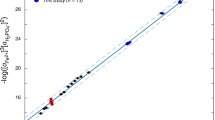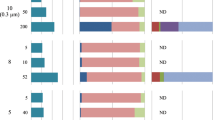Abstract
The origin and structure of the dissolved blue-fluorescent yellow organic substances (Gelbstoff) in seawater have long eluded characterization1. The fact that this class of organic matter, which comprises 10–50% of the organic carbon in the sea2, became known as marine humus (fulvic and humic acids) has led to much confusion because of the implied relationship with soil humus3. Based on chemical and spectral studies of oceanic and coastal humus we recently proposed a class structure and a mechanism by which these marine humic substances could form2. The hypothesis was that they are water soluble, aliphatic organic acids formed by the autoxidative cross-linking of two or more unsatur-ated lipids released into seawater. We have now confirmed that hypothesis by allowing pure marine lipids and a diatom to autoxidize in seawater in the laboratory. We report here that the yellow substances obtained are similar in all respects to marine humus.
This is a preview of subscription content, access via your institution
Access options
Subscribe to this journal
Receive 51 print issues and online access
$199.00 per year
only $3.90 per issue
Buy this article
- Purchase on Springer Link
- Instant access to full article PDF
Prices may be subject to local taxes which are calculated during checkout
Similar content being viewed by others
References
Kalle, K. Dt. Hydrogr. Z. 2, 117–124 (1949).
Harvey, G. R., Boran, D. A., Chesal, L. A. & Tokar, J. M. Mar. Chem. 12, 119–132 (1983).
Pocklington, R. Mar. Chem. 5, 479–496 (1977).
Stuermer, D. H. & Harvey, G. R. Deep-Sea Res. 24, 303–309 (1977).
Fu, T. & Pocklington, R. Mar. Chem. 13, 255–264 (1983).
Ackman, R. G., Jangaard, P. M., Hoyle, R. J. & Brockerhoff, H. J. Fish. Res. Bd Can. 21, 747–756 (1964).
Stuermer, D. H. & Harvey, G. R. Nature 250, 480–481 (1974).
Thurman, E. M., Wershaw, R. L., Malcolm, R. L. & Pinckney, D. J. Org. Cheochem. 4, 27–36 (1982).
Piotrowicz, S. R., Springer-Young, M., Puig, J. A. & Spencer, M. J. Analyt. Chem. 54, 1367–1371 (1982).
Piotrowicz, S. R., Harvey, G. R., Springer-Young, M., Courant, R. A. & Boran, D. A. . in Trace Metals in Sea Water (eds Wong, C. S., Boyle, E., Bruland, K., Burton, J. D. & Goldberg, E. D. 699–718 (Plenum, New York, 1983).
Ortner, P. B., Kreader, C. & Harvey, G. R. Nature 301, 1–3 (1983).
Nelson, N. A., Kelly, R. C. & Johnson, R. A. Chem. Engng News, 30–34 (1982).
Burton, G. W. & Ingold, K. U. J. Am. chem. Soc. 103, 6472–6477 (1981).
Author information
Authors and Affiliations
Rights and permissions
About this article
Cite this article
Harvey, G., Boran, D., Piotrowicz, S. et al. Synthesis of marine humic substances from unsaturated lipids. Nature 309, 244–246 (1984). https://doi.org/10.1038/309244a0
Received:
Accepted:
Issue Date:
DOI: https://doi.org/10.1038/309244a0
This article is cited by
-
Vis/NIR Chemical Imaging Technique for Predicting Sodium Humate Contents in Aquaculture Environment
Water, Air, & Soil Pollution (2017)
-
Chromophoric Dissolved Organic Matter (CDOM) In Rainwater, Southeastern North Carolina, USA
Journal of Atmospheric Chemistry (2006)
Comments
By submitting a comment you agree to abide by our Terms and Community Guidelines. If you find something abusive or that does not comply with our terms or guidelines please flag it as inappropriate.



